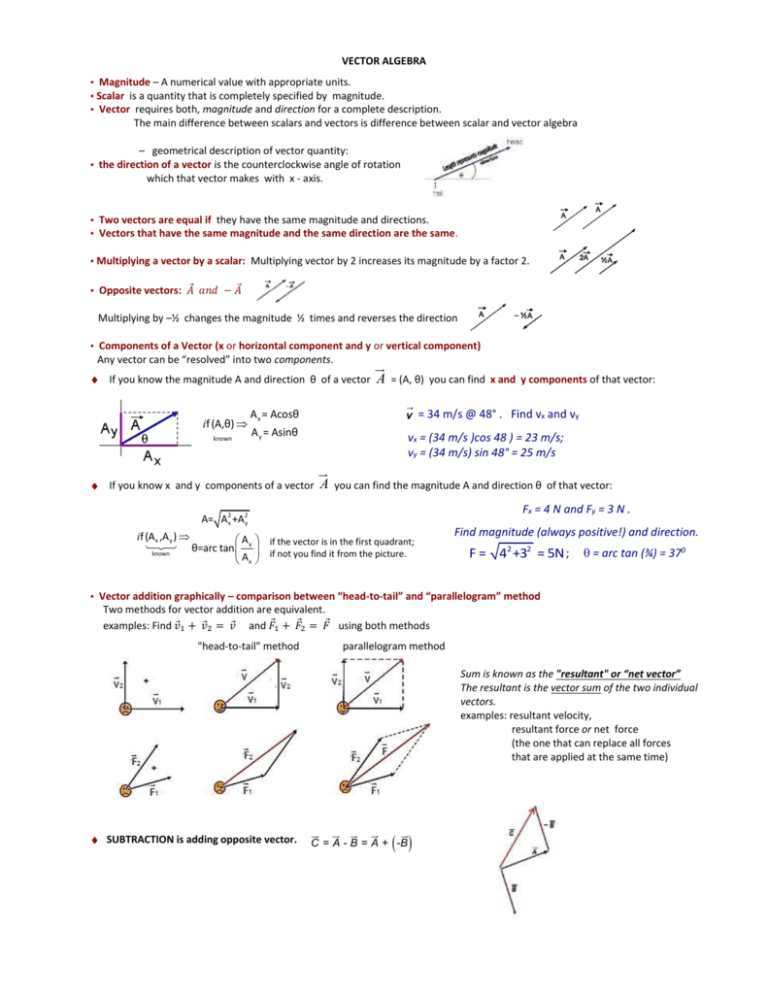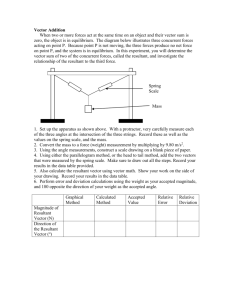VECTOR ALGEBRA Magnitude – A numerical value with
advertisement

VECTOR ALGEBRA ▪ Magnitude – A numerical value with appropriate units. ▪ Scalar is a quantity that is completely specified by magnitude. ▪ Vector requires both, magnitude and direction for a complete description. The main difference between scalars and vectors is difference between scalar and vector algebra – geometrical description of vector quantity: ▪ the direction of a vector is the counterclockwise angle of rotation which that vector makes with x - axis. ▪ Two vectors are equal if they have the same magnitude and directions. ▪ Vectors that have the same magnitude and the same direction are the same. ▪ Multiplying a vector by a scalar: Multiplying vector by 2 increases its magnitude by a factor 2. ▪ Opposite vectors: 𝐴⃗ 𝑎𝑛𝑑 − 𝐴⃗ Multiplying by –½ changes the magnitude ½ times and reverses the direction ▪ Components of a Vector (x or horizontal component and y or vertical component) Any vector can be “resolved” into two components. If you know the magnitude A and direction θ of a vector if (A,θ) known A = (A, θ) you can find x and y components of that vector: A x = Acosθ v = 34 m/s @ 48° . Find vx and vy A y = Asinθ vx = (34 m/s )cos 48 ) = 23 m/s; vy = (34 m/s) sin 48° = 25 m/s If you know x and y components of a vector A you can find the magnitude A and direction θ of that vector: Fx = 4 N and Fy = 3 N . A= A2x +A2y if (A x ,A y ) known A if the vector is in the first quadrant; θ=arc tan y if not you find it from the picture. Ax Find magnitude (always positive!) and direction. F = 42 +32 = 5N ; = arc tan (¾) = 370 ▪ Vector addition graphically – comparison between “head-to-tail” and “parallelogram” method Two methods for vector addition are equivalent. examples: Find 𝑣⃗1 + 𝑣⃗2 = 𝑣⃗ and 𝐹⃗1 + 𝐹⃗2 = 𝐹⃗ using both methods "head-to-tail" method parallelogram method Sum is known as the "resultant" or “net vector” The resultant is the vector sum of the two individual vectors. examples: resultant velocity, resultant force or net force (the one that can replace all forces that are applied at the same time) SUBTRACTION is adding opposite vector. C = A - B = A + -B ▪ ANALYTICALLY: ⃗⃗ 𝐶⃗ = 𝐴⃗ + 𝐵 𝐶𝑥 = 𝐴𝑥 + 𝐵𝑥 = 𝐴 cos 𝜃𝐴 + 𝐵𝑐𝑜𝑠 𝜃𝐵 𝐶𝑦 = 𝐴𝑦 + 𝐵𝑦 = 𝐴 𝑠𝑖𝑛 𝜃𝐴 + 𝐵𝑠𝑖𝑛 𝜃𝐵 𝐶 = √𝐶𝑥2 + 𝐶𝑦2 ; from the picture F = 68 N @ 24° 1 F2 = 32 N @ 65° Find F F1 F2 Fx = F1x + F2x = 68 cos240 + 32 cos650 = 75.6 N Fy = F1y + F2y = 68 sin240 + 32 sin650 = 56.7 N F Fx2 Fy2 94.5 N = arc tan (56.7/75.6) = 36.90 F 94.5N @ 370






